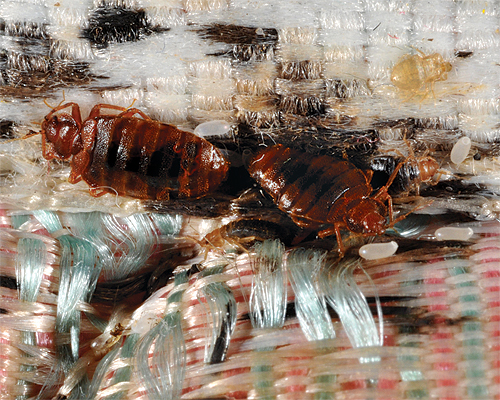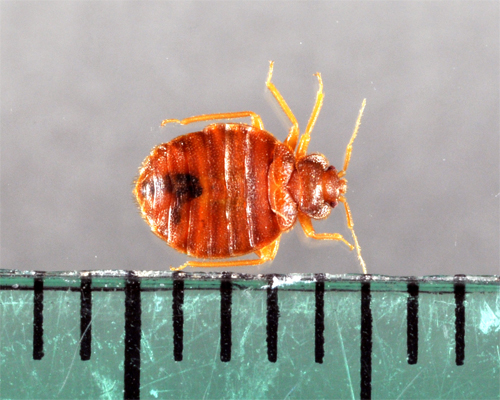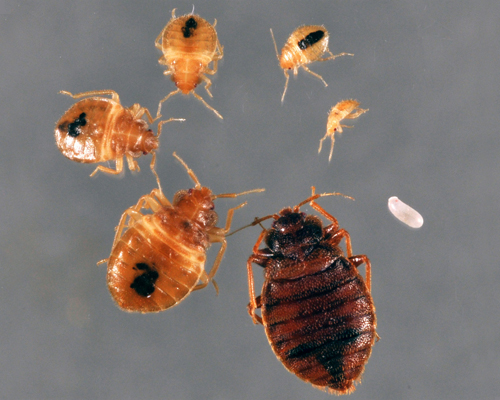
Fact Sheet FS1117
As bed bugs become more and more common in our society, many people are increasingly concerned about bed bug infestations. Bed bugs are very difficult to find and can be quite costly to control if not detected early. Additionally, it is difficult to determine if any bed bugs are still present following control efforts. This publication describes several tools that help detect the presence of bed bugs.
Many commercial bed bug monitors are available for detecting bed bugs. Among them, pitfall-style traps are the most cost-effective for detecting bed bugs (Wang et al. 2009a, 2011). The ClimbupTM Insect Interceptor with its outer surface covered by fabric tape (Susan McKnight Inc, Memphis, TN) was shown to be particularly effective. Pitfall-style traps are placed under the legs of beds and upholstered furniture to intercept bed bugs that are dispersing from the furniture or trying to reach the furniture for a blood meal. The device does not contain any attractants. Thus, it is considered a passive monitor. Passive pitfall traps take advantage of two bed bug behavioral characteristics: active searching for a human host upon which to feed, and tendency for climbing vertical coarse surfaces. The furniture must be pulled away from walls, and any other bridges between the furniture and the floors must be eliminated. Interceptors need to be in place for at least a week or longer to detect bed bugs at very low numbers. Studies have shown that interceptors are much more effective than visual inspections and information obtained from interviews of building occupants (Wang et al. 2016).
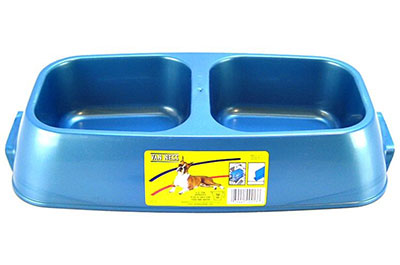
Figure 1.
Passive pitfall monitors are more likely to reduce the number of bed bug bites when placed under legs of beds and upholstered furniture by stopping the bed bug from reaching the resident. However, some beds may lack a frame or the bed legs are too big. In these cases, passive pitfall traps may be placed against the walls and legs of beds and furniture, which would slightly reduce the bed bug detection rate.
An alternative bed bug monitoring method is to use monitors baited with bed bug attractants. Bed bugs are attracted to carbon dioxide (CO2), heat, and chemical lure emitted from the host (Wang et al. 2009b). CO2 is the primary attractant to bed bugs, and when a CO2 source is added to a trap, the trap can be very effective for detecting bed bugs. Studies have shown that both the dry ice or sugar-yeast fermentation method can provide a reliable and effective source of CO2 for monitoring bed bugs (Wang et al. 2011, Singh et al. 2015). One night of trapping can detect the presence of low numbers of bed bugs in occupied or vacant rooms. Tests in apartments indicate that a dry ice trap or sugar-yeast trap is equally or more effective than the non-baited pitfall-style bed bug monitors. Compared to non-baited pitfall traps, dry ice or sugar-yeast traps can detect bed bugs more quickly.
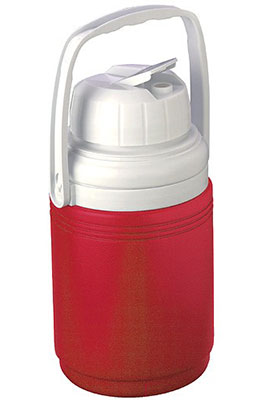
Figure 2.
There are some inherent safety risks that are associated with dry ice. Dry ice is also not readily available. A sugar-yeast trap is easy to make, but requires a large container. When properly made and used, both dry ice traps and sugar-yeast traps offer an effective method for individuals that cannot afford professional bed bug inspection services. The following are step-by-step instructions on how to make and use dry ice traps and sugar-yeast traps to monitor bed bugs.
Making a dry ice trap
- Start by buying a 32 oz capacity double bowl cat feeder (35.5 × 17.5 × 7 cm, Figure 1) or a dog bowl, a 1/3 gallon insulated container (jug) or insulated coffee cup (Figure 2), and a bottle of talc powder from a local retail store. A 64 oz round single bowl cat feeder works equally well. You may also use a Climbup XL (extra large) Insect Interceptor that is commercially available. Talc is available as baby powder products in retail stores. The jug is used to hold dry ice. Dry ice is the solid phase of CO2. At room temperature, it changes (a process called sublimation) into CO2 gas, which attracts bed bugs. Once filled, a 1/3 gallon container (jug) can release CO2 for 10–12 hours. In an air-conditioned room, the CO2 release rate from a 1/3 gallon jug is about the same as that from two people.
- Cover the exterior surface with surgical tape or roughen the exterior surface of the cat feeder with sand paper. Alternatively, attach a piece of cloth to the exterior surface of the cat feeder with masking tape (Figure 3). Dark-colored fabric is preferred to increase the attractiveness of the trap. The upper edge of the fabric needs to be tightly attached to the cat feeder to prevent bed bugs from hiding under the fabric. The goal is to allow bed bugs to climb up the cat feeder easily. If you are using Climbup XL as the pitfall trap, then you do not need to do any preparation because its exterior surface is already covered with surgical tape. Apply a very thin layer of talc with a cotton ball to the interior surfaces of the inverted cat feeder. The powder prevents trapped bed bugs from escaping. You are now ready to use your own bed bug monitor to detect bed bugs.
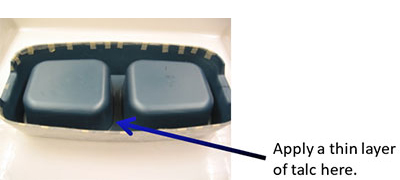
Figure 3.
Using Dry Ice Traps (Please Note This Method Is Not Registered for Commercial Use by Professionals)
- Find a local dry ice vendor from the following website: www.dryicedirectory.com. Dry ice costs around $1.2 per pound. Bring a foam cooler with you when buying dry ice. Dry ice pellets are easier to handle than large chunks of dry ice. You can temporarily store dry ice along with the foam cooler in a freezer for several days. Ten pounds of dry ice lasts 3–4 days when stored in a freezer.
Use Caution When Handling Dry Ice!
Dry ice is VERY COLD (-109.3°F) and can freeze on contact causing skin injury!
Dry ice releases carbon dioxide, which could cause a decrease in the concentration of oxygen in the body!
- Always wear hand protection
- Keep out of reach of children
- Transport in well-ventilated conditions
- Do not store in a confined space, such as a closet, or walk-in freezer
- If storing in a freezer, the freezer should be located in a well-ventilated area
- Deploy the trap in a ventilated area
- Fill up the insulated container (jug) with dry ice (1/3 gallon jug holds about 2.5 lb. dry ice). Leave the opening of the jug slightly open. Place them on top of the inverted cat feeder (Figure 4). Make sure the jug does not touch the edge of the cat feeder. You may add a little soapy water (barely covering the bottom of the feeder) to kill the bed bugs that are trapped. Place a warning sign or tape on the monitor to prevent children from tampering with the trap and to avoid accidental injury or ingestion of dry ice. If necessary, use tape to secure the top of the jug. Now the dry ice trap is ready to attract and catch bed bugs.
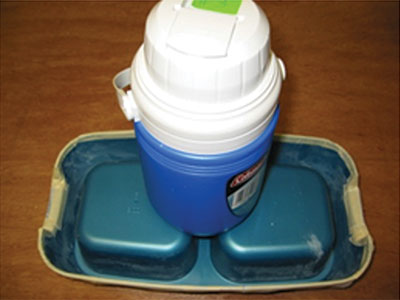
Figure 4.
- Place the trap beside the bed or sofa where most of the bed bugs usually hide. Set up the trap in late afternoon to maximize the catches because bed bugs are most active during the night. Leaving the room unoccupied during the trapping period is not necessary but is helpful. Place one trap in each room if multiple rooms are suspected of having bed bugs. Only one trap should be used per room. Avoid using a fan near the trap.
- Check both the outside and inside of the cat feeder the next day. A trap can catch a few bugs to hundreds or even more than a thousand bed bugs per night depending on infestation levels (Figure 5). Occasionally, bed bugs may stay on the fabric covering the exterior surface of the cat feeder. Since young bed bug stages are very small, using a magnifier will help identify them. After examining the trap, discard the trapped bed bugs into a toilet and flush them into the drain or place the bugs in a sealed bag and then place in an outside garbage.
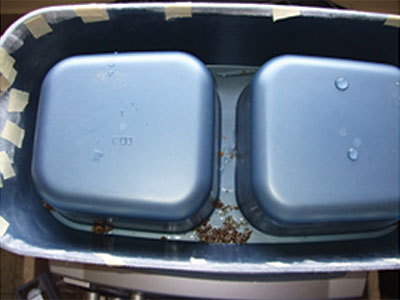
Figure 5.
- If no bed bugs are caught after one night, you can set up the trap again for several more days to increase the likelihood of identifying the presence of bed bugs. This is necessary because not all bed bugs are attracted to the trap in one day and bed bug eggs may be present in the room. You need to replenish the dry ice every day. Before reusing the cat feeder, make sure the talc is present.
- If you do not capture any bed bugs but are still being bitten or suspect having bed bugs, you should hire a skilled professional to inspect and provide recommendations. You may also add multiple passive pitfall monitors under furniture legs, around furniture, or against perimeter walls to increase the probability of detecting very low numbers of bed bugs.
- Bed bugs may lay eggs on the cat feeder. So, store the used cat feeder in a freezer for at least four days or in a sealed plastic bag after use.
Making a Sugar-Yeast Trap
- Obtain a 4–5 gallon bucket. Fill it with a mixture of 150 g yeast, 750 g granulated cane sugar, and 3 liters warm water (about 104 °F or 40 °C). Mix all ingredients thoroughly immediately before setting up the trap.
- Place the bucket over two inverted cat feeders or dog bowls that are prepared as described in previous steps for dry ice trap (Figure 6). The bucket should be covered loosely with a lid to prevent pets or other objects from falling in. Place a piece of wood or any other type of material on top of the dog bowls so the edge of the walls of the dog bowls will not touch the bucket. Otherwise the bed bugs may climb onto the bucket.
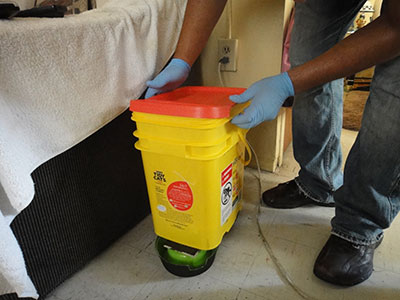
Figure 6.
- Add a SenSci Activ bed bug lure (senscionline.com/activ) in the dog bowls to increase the trap catch.
Using a Sugar-Yeast Trap
For best results, set up the trap in evening hours. The sugar-yeast mixture will release CO2 at an adult's respiration rate for about 8 hours. If an additional monitoring is needed, the bucket may be emptied and refilled with sugar, yeast, and warm water at the formula mentioned in step 1.
While bed bug monitors help to reduce bed bug numbers, people should not rely solely on bed bug monitors for controlling bed bugs. Monitors are only intended to detect bed bugs and monitor control efforts. Once bed bugs are found, proper treatments should be taken to eliminate the infestation promptly (FS1251).
I appreciate the critical review of an earlier draft by Dr. Richard Cooper (Terminix, Philadelphia, PA) and Dr. Steven Kells (Department of Entomology, University of Minnesota).
References
- Singh, N., C. Wang, R. Cooper. 2015. Effectiveness of a sugar–yeast monitor and a chemical lure for detecting bed bugs. Journal of Economic Entomology 108: 1298–1303.
- Wang, C., T. J. Gibb., and G. W. Bennett. 2009a. Interceptors assist in bed bug monitoring. Pest Control Technology 37(4): 112, 114.
- Wang, C., T. Gibb, G. W. Bennett, and S. McKnight. 2009b. Bed bug attraction to pitfall traps baited with carbon dioxide, heat, and chemical lure. Journal of Economic Entomology 102: 1580–1585.
- Wang, C., W. T. Tsai, R. Cooper, J. White. 2011. Effectiveness of bed bug monitors for detecting and trapping bed bugs in apartments. Journal of Economic Entomology 104: 274–278.
- Wang, C., N. Singh, C. Zha, R. Cooper, 2016. Bed bugs: prevalence in low-income communities, resident's reactions, and implementation of a low-cost inspection protocol. Journal of Medical Entomology 53: 639–646.
Mention or display of a trademark, proprietary product, or firm in text or figures does not constitute an endorsement by Rutgers Cooperative Extension and does not imply approval to the exclusion of other suitable products or firms.
Photo credits: Changlu Wang
June 2019
Copyright © 2024 Rutgers, The State University of New Jersey. All rights reserved.
For more information: njaes.rutgers.edu.
Cooperating Agencies: Rutgers, The State University of New Jersey, U.S. Department of Agriculture, and Boards of County Commissioners. Rutgers Cooperative Extension, a unit of the Rutgers New Jersey Agricultural Experiment Station, is an equal opportunity program provider and employer.


